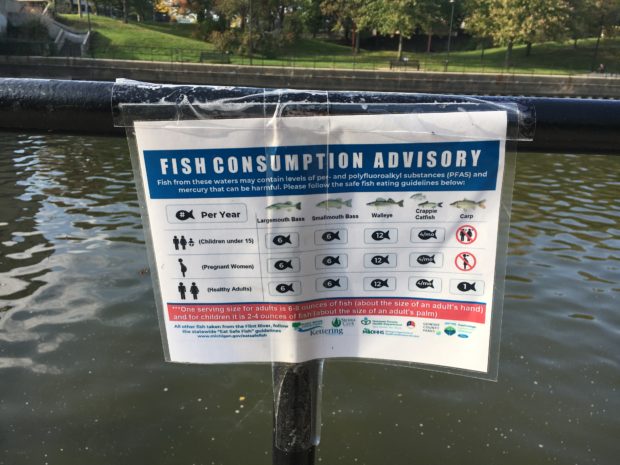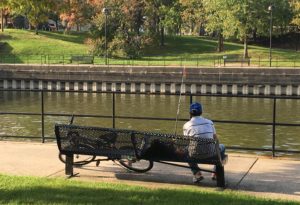
An angler at the Flint River. Image: Rocío Cano Muñoz
By Rocío Cano Muñoz
Next to the Flint River in Flint, Michigan, is a park full of trees with a plaque that commemorates the 25th anniversary of Earth Day.
The sound of the water flowing through that river and the nature around it, helps explain why that plaque is there. Near a red bridge, people photograph the landscape. Nearby, men fish while, standing and looking at the water cascade or they sit and wait for a bite.
Near the water and hanging on the railing that keeps people from falling in, is a fish consumption advisory.
“Fish from these waters may contain levels of per- and polyfluoroalkyl substances (PFAS) and mercury that can be harmful,” it reads. “Please follow the safe fish eating guidelines below.”

A fish consumption advisory next to the Flint River at Flint, Michigan. Image: Rocío Cano Muñoz
The advisory lists five types of fish that you can find in the Flint River. It recommends limits on the number of fish per year children under fifteen, pregnant women and healthy adults should eat. Largemouth and smallmouth bass from the river should be eaten just six times per year. Walleye should be eaten 12 times a year, and crappie and catfish four times per month.
For carp, the advisory shows that children under fifteen and pregnant women shouldn’t eat them at all. Healthy adults are allowed just one carp meal per year.
The Flint River has not only shown problems with the levels of the substances that the advisory says are in it. The Flint water crisis in 2014 brought attention to how the corrosive nature of the water caused lead to leach into the drinking water system. That happened when the city’s water source was switched from Detroit to the river to reduce costs.
In that crisis, General Motors said that the water generated corrosion on the engines it built in a Flint factory, and residents began to complain to city authorities that the water that came out at their houses was dirty and smelled bad.
At the recent 28th Society of Environmental Journalists annual conference in Flint, Flint resident LaShaya Darisaw and her daughter explained how they struggled with this issue.

An angler waits for a fish to bite at the Flint River in Flint, Michigan. Image: Rocío Cano Muñoz
“Long before there was a water crisis, toxins were dumped into the river,” Darisaw said. “No one should eat anything from the river at all.”.
Darisaw is unsure if people know about the fish advisory: “I had not heard about it. There definitely should be more information available.”.
The issue prompts questions about water rights and people’s right to eat. Trina Downer, a Flint area resident, wore a blue t-shirt at the conference that read “#WaterisLifeForEveryone” and “#CleanWater.” She, too, was affected by the water contaminants in that crisis, she said. “I was going to school here at Flint when everything happened. I also got poisoned. I’ve had a couple of surgeries in the hospital.”.
Downer also did not know about the fish advisory. She said many people eat more fish than the advisory recommends.
“People still need to eat,” she said. “We are down to the bare basics, we don’t have any money, people are sick, they can’t go to work, what else are they going to eat?”
“If they are fishing in the Flint River to eat their fish, they are eating a lot more than that… they have to,” she said.
Downer said she is sad for the people, but also sees that life has to happen. People are taking their chances to eat today, but maybe shorten their lives, she said. And she questions if the information is available to the public.
If it isn’t also in Spanish or Arabic, “we are not telling our residents,” she said.
The health of the river is not as gloomy as some people portray it, said Heather Dawson, an associate professor of fisheries and wildlife biology at the University of Michigan in Flint.
“People look at it and it’s sort of muddy looking and people think ‘Oh, it’s not a good river,’ but it actually has a lot of fish in it (and) can be healthy in a lot of regards,” she said. “But people should continue to eat the fish, just following the advisories.”
Such challenges are not confined to the U.S. A similar situation occurs in Chile. People live in places called sacrifice zones, like Quintero and Ventanas, where industries line the beaches that were once places for vacations. Recent news images showed pieces of coal in the sand.
Chile’s Undersecretary of Fisheries and Aquaculture in September of 2016 reported the impacts on the marine ecosystems near an oil spill at Bahía Quintero, which is in the region of Valparaiso. It found high levels of metals in crustaceans and mollusks.
“The highest levels of this element were detected in the area of Farellones of Quintero, Loncura and Ventanas,” the agency reported. “The origin of these levels in the last two may be related to the industrial activity in the area.”
The Oceana Foundation in Chile reports that the fishermen in Ventanas had to change their jobs because of the shortage of fish and shellfish. The Chilean press has reported similar issues and protests like those in the Flint water crisis for over a decade.
A new conflict has recently arisen in Quintero. People started getting sick again, and they are trying to find the causes of this health problem.
They are causes that people who were picking mollusks long ago did not think about.
Rocío Cano Muñoz is a journalism student at the Pontificia Universidad Católica in Santiago, Chile, and was a recent participant in a Knight Center workshop for Chilean journalists and journalism students interested in reporting on the environment.
